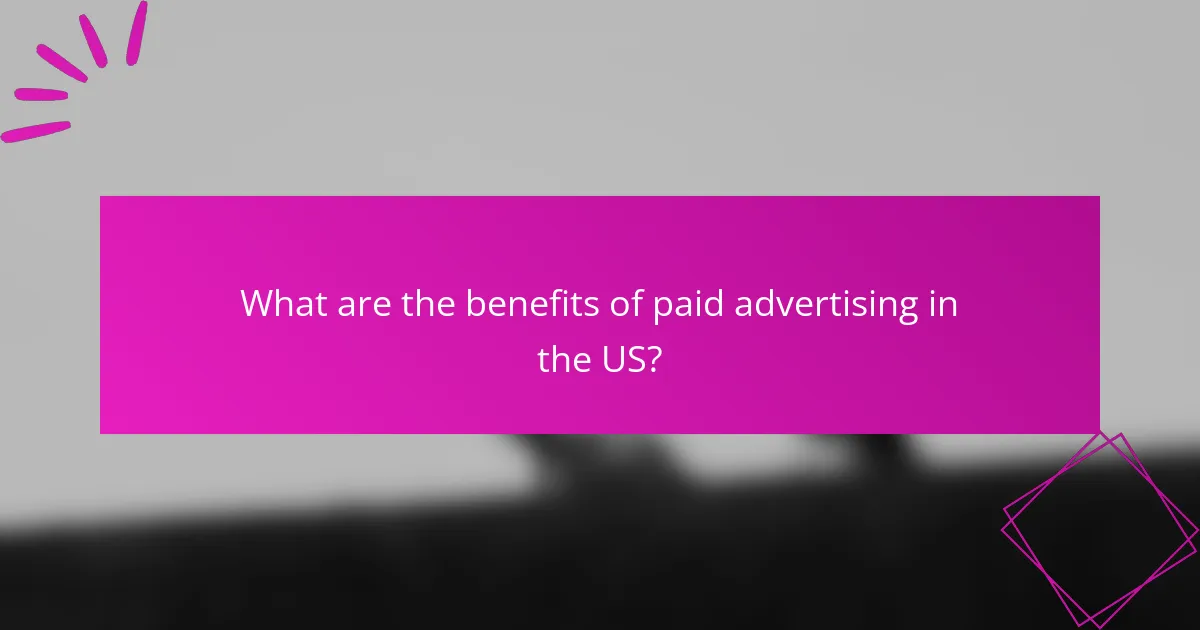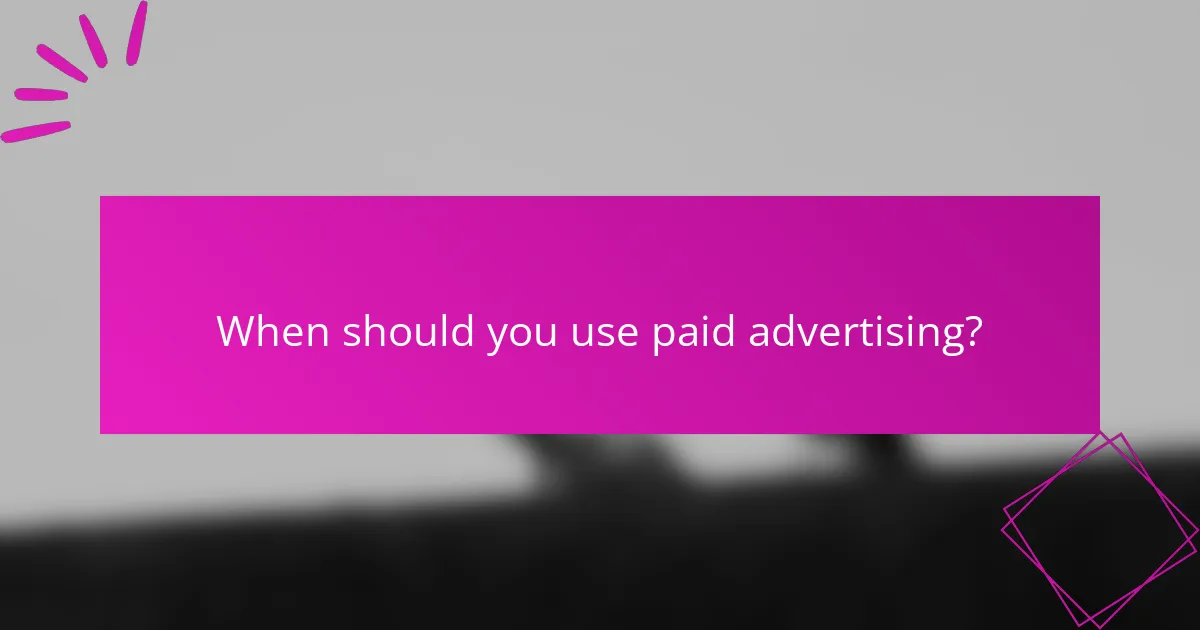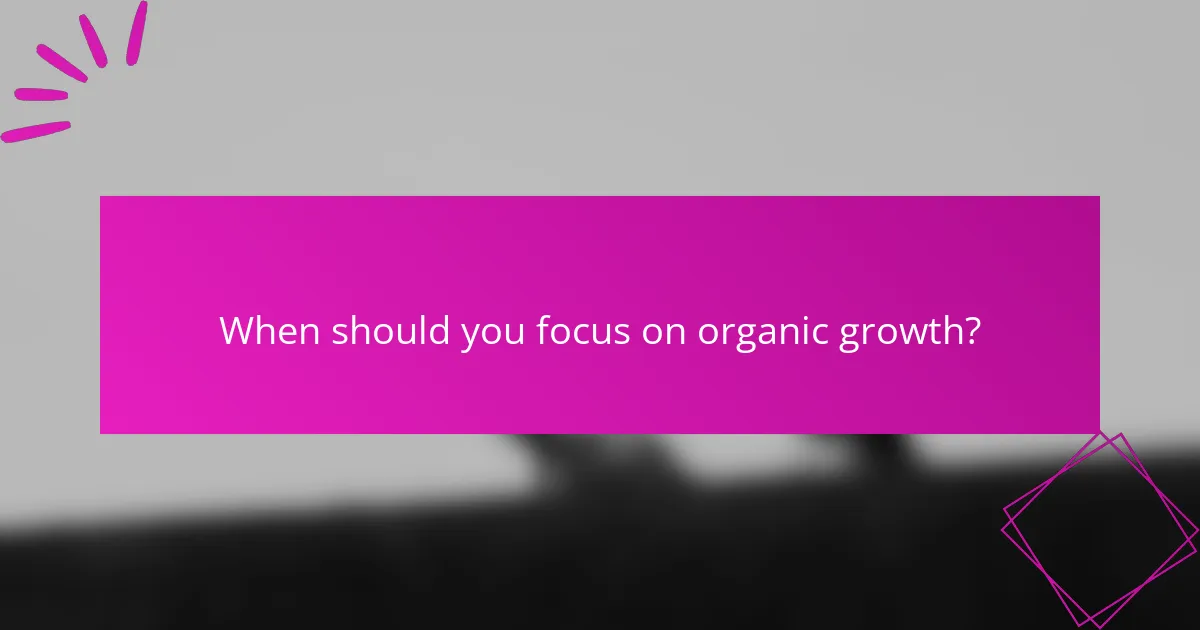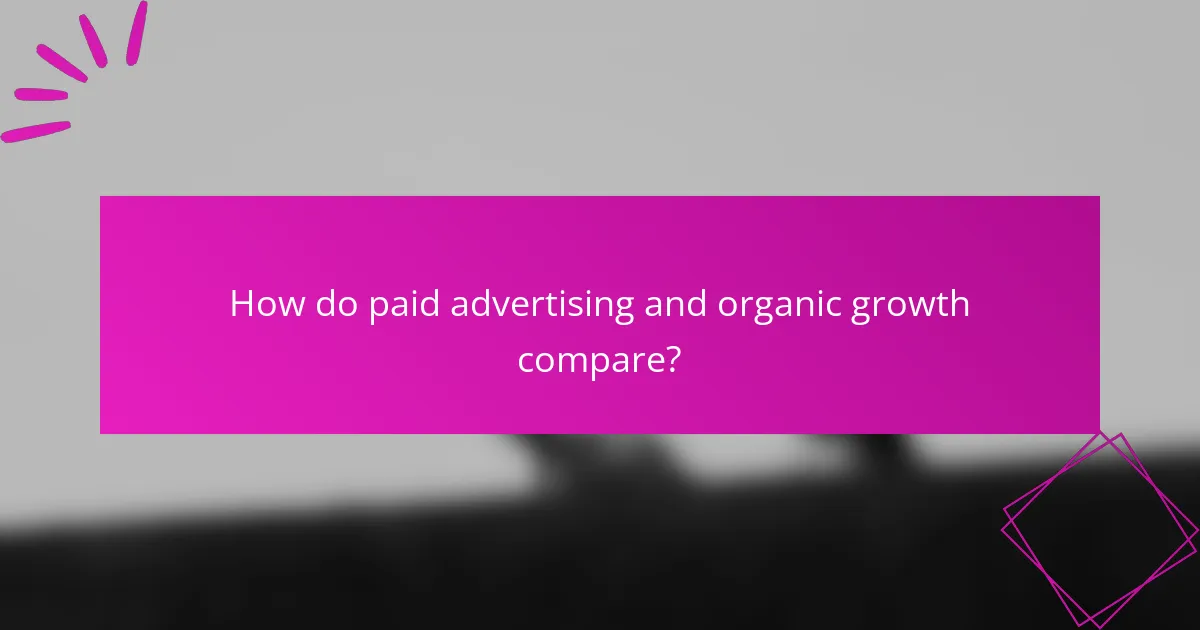In the debate between paid advertising and organic growth, each strategy offers distinct advantages depending on business goals and timelines. Paid advertising provides immediate visibility and targeted outreach, making it ideal for short-term campaigns and new product launches. Conversely, organic growth fosters long-term brand loyalty and cost savings through consistent content and engagement efforts. Understanding when to leverage each approach is key to maximizing marketing effectiveness.

What are the benefits of paid advertising in the US?
Paid advertising in the US offers businesses immediate access to potential customers, allowing for quick visibility and targeted outreach. This approach can be particularly effective for driving traffic and generating leads in a competitive market.
Immediate visibility
Paid advertising provides instant visibility on platforms like Google and social media. Unlike organic methods, which can take time to build momentum, paid ads can place your brand at the top of search results or in front of users’ feeds almost immediately.
This rapid exposure can be crucial for time-sensitive promotions or product launches, enabling businesses to capture attention when it matters most.
Targeted audience reach
With paid advertising, you can precisely target your audience based on demographics, interests, and behaviors. Platforms like Facebook and Google Ads allow you to tailor your campaigns to reach specific groups, increasing the likelihood of engagement.
This targeted approach helps ensure that your advertising budget is spent efficiently, reaching those most likely to convert rather than a broad audience that may not be interested.
Measurable results
Paid advertising campaigns are highly measurable, providing detailed analytics on performance. You can track metrics such as click-through rates, conversion rates, and return on ad spend, allowing for data-driven decisions.
This level of insight enables businesses to optimize their campaigns in real-time, adjusting strategies based on what works best to maximize effectiveness.
Brand awareness boost
Investing in paid advertising can significantly enhance brand awareness. Frequent exposure through ads can help establish your brand in the minds of consumers, making it more recognizable over time.
Even if users do not click on your ads, repeated visibility can lead to increased familiarity, which is crucial for building trust and encouraging future engagement with your brand.

When should you use paid advertising?
Paid advertising is best utilized when immediate visibility and traffic are crucial for your business goals. This approach is particularly effective for short-term campaigns or when launching new products, as it allows for rapid audience engagement and brand awareness.
Product launches
For product launches, paid advertising can create immediate buzz and attract potential customers quickly. Consider using platforms like Google Ads or social media ads to target specific demographics and interests related to your new offering. A well-timed ad campaign can significantly boost initial sales and brand recognition.
Allocate a budget that reflects the expected return on investment, typically ranging from a few hundred to several thousand dollars, depending on your market size and product type. Monitor performance closely to adjust strategies as needed.
Seasonal promotions
Seasonal promotions benefit greatly from paid advertising, as they capitalize on heightened consumer interest during specific times of the year. Utilize targeted ads to reach customers looking for holiday deals or seasonal products, ensuring your offerings stand out amidst the competition.
Consider running ads a few weeks before the peak season to build awareness and drive traffic. A budget of 10-20% of your expected seasonal revenue can be a good starting point for ad spend.
Competitive markets
In competitive markets, paid advertising can help differentiate your brand and capture market share. Use targeted ads to highlight unique selling points and promotions that set you apart from competitors. This approach can be particularly effective in industries where organic growth is slow due to high competition.
Regularly analyze competitors’ ad strategies to identify gaps you can exploit. A budget that allows for continuous testing and optimization—often in the range of several hundred to thousands of dollars monthly—can yield significant advantages in visibility and customer acquisition.

What are the benefits of organic growth in the US?
Organic growth in the US offers several advantages, including cost savings and enhanced brand loyalty. This approach focuses on building a strong online presence through content and engagement rather than relying solely on paid advertising.
Cost-effectiveness
Organic growth is generally more cost-effective than paid advertising. While initial investments in quality content and SEO strategies are necessary, the long-term benefits often outweigh these costs. Businesses can save significantly by avoiding ongoing ad spend, which can quickly add up.
For instance, creating valuable blog posts or engaging social media content can attract visitors without the need for continuous payment. This approach can lead to a sustainable flow of traffic over time.
Long-term sustainability
Organic growth fosters long-term sustainability by building a loyal customer base. Unlike paid ads that stop generating traffic once the budget is exhausted, organic strategies can continue to yield results for months or even years after implementation.
Investing in search engine optimization (SEO) and quality content ensures that a business remains visible in search results, which can lead to consistent user engagement. This sustained visibility helps in maintaining a steady stream of potential customers.
Trust and credibility
Organic growth enhances trust and credibility among consumers. Users often perceive organic search results as more reliable compared to paid ads, which can lead to higher conversion rates. When a brand consistently delivers valuable content, it builds authority in its niche.
For example, a company that regularly publishes informative articles or helpful resources is more likely to be viewed as an industry leader. This perception can significantly influence purchasing decisions, as consumers tend to favor brands they trust.

When should you focus on organic growth?
Focusing on organic growth is ideal when you aim to build a sustainable brand presence and foster long-term customer relationships. It is particularly beneficial for businesses with limited budgets or those looking to enhance their credibility and trustworthiness over time.
Building brand loyalty
Organic growth strategies, such as engaging content and community interaction, are essential for cultivating brand loyalty. When customers feel connected to your brand through authentic experiences, they are more likely to return and recommend your products or services to others.
To build loyalty, prioritize customer engagement through social media, personalized email marketing, and interactive content. Consistency in messaging and values also plays a crucial role in reinforcing customer trust.
Content marketing strategies
Content marketing is a cornerstone of organic growth, focusing on creating valuable, relevant content that attracts and retains a target audience. This can include blog posts, videos, infographics, and podcasts that address customer pain points and interests.
Effective content marketing requires a clear strategy, including identifying your audience, setting goals, and measuring performance. Regularly updating your content and optimizing it for search engines can significantly enhance visibility and engagement.
SEO optimization
Search Engine Optimization (SEO) is vital for driving organic traffic to your website. It involves optimizing your website’s content, structure, and technical aspects to improve its ranking on search engine results pages.
Key SEO practices include keyword research, on-page optimization (like meta tags and headings), and building backlinks from reputable sites. Regularly monitoring your SEO performance and adapting to algorithm changes can help maintain and improve your organic visibility.

How do paid advertising and organic growth compare?
Paid advertising and organic growth are two distinct strategies for increasing visibility and attracting customers. Paid advertising delivers immediate results, while organic growth builds a sustainable presence over time.
Cost analysis
Paid advertising typically involves upfront costs, such as pay-per-click (PPC) campaigns or social media ads. Depending on the platform and competition, costs can range from a few cents to several dollars per click.
In contrast, organic growth primarily requires investment in content creation and SEO, which can be lower in the long run but may take time to yield results. Businesses should weigh the immediate costs of paid ads against the long-term benefits of organic strategies.
Time investment
Paid advertising can generate traffic almost instantly, making it suitable for time-sensitive promotions or product launches. Campaigns can be set up quickly, often within a few hours.
Organic growth, however, demands a significant time investment for content development, SEO optimization, and community engagement. It may take weeks or months to see substantial results, so businesses need to plan accordingly.
Audience engagement
Paid advertising can effectively reach a broad audience, but it may not foster deep engagement. Users often view ads as interruptions, which can lead to lower interaction rates.
Organic growth tends to build stronger relationships with the audience through valuable content and consistent interaction. This approach encourages loyalty and trust, leading to higher engagement levels over time.

What are the key metrics to evaluate success?
To evaluate the success of paid advertising versus organic growth, focus on metrics that directly reflect performance and return. Key metrics include Return on Investment (ROI) and Click-through Rates (CTR), which provide insights into the effectiveness and efficiency of your marketing efforts.
Return on investment (ROI)
ROI measures the profitability of your advertising campaigns relative to the costs incurred. It is calculated by taking the net profit from the campaign, dividing it by the total costs, and multiplying by 100 to get a percentage. A positive ROI indicates that your advertising is generating more revenue than it costs.
For example, if you spend $1,000 on a campaign and generate $3,000 in sales, your ROI would be 200%. Generally, a good ROI in digital marketing is considered to be around 300% or more, but this can vary by industry and campaign type.
When evaluating ROI, consider both short-term and long-term returns. Paid advertising may yield quick results, while organic growth strategies often build value over time. Balancing both approaches can lead to sustainable growth.
Click-through rates (CTR)
CTR is the ratio of users who click on your ad or link to the total number of users who view it. It is expressed as a percentage and serves as an indicator of how compelling your ad or content is. A higher CTR typically signifies that your audience finds your offering relevant and engaging.
For instance, if your ad is shown 1,000 times and receives 50 clicks, your CTR would be 5%. Average CTRs can vary widely by platform, with search ads often achieving higher rates than display ads, typically ranging from 1% to 5% for many industries.
To improve CTR, focus on crafting clear, persuasive ad copy and using targeted keywords. Avoid common pitfalls such as vague messaging or irrelevant targeting, which can lead to lower engagement and wasted ad spend.
